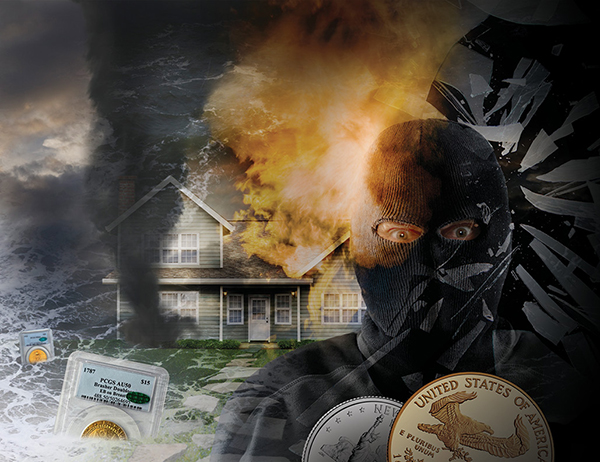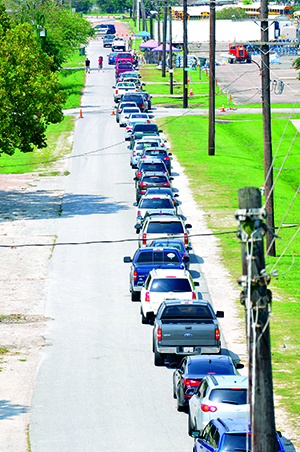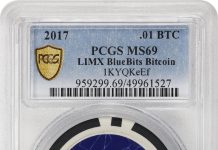
By Scott A. Travers
Hurricane Florence in 2018; Hurricanes Harvey and Irma in 2017; Superstorm Sandy in 2012; Hurricane Katrina in 2005; and the Napa Valley fires of 2017 have focused Americans’ attention over and again on the grim consequences of a potential disaster. Whether man-made or natural, the need to be prepared for such a catastrophe is of supreme importance.
The phrase “potential disaster” also encompasses such ominous black swan events as a nuclear weapon of mass destruction being unleashed by a terrorist force on a major U.S. city and an electromagnetic pulse (EMP) attack that could potentially cripple a significant portion of the U.S. power grid and render useless unprotected electronic devices. A nuclear event or an EMP attack could lead to mass death and destruction of such insurmountable magnitude that it would pose a threat to all humanity.
 Simple survival is the principal priority, of course. The U.S. Department of Homeland Security has made survival guidelines available for nuclear events. But beyond safeguarding your person, anyone who collects rare coins or has gold or silver bullion as a form of “insurance” should give careful consideration to how those coins or bullion would be safeguarded or accessed in an emergency – and how he or she would be protected against serious financial loss in the event these assets were lost, damaged, or destroyed.
Simple survival is the principal priority, of course. The U.S. Department of Homeland Security has made survival guidelines available for nuclear events. But beyond safeguarding your person, anyone who collects rare coins or has gold or silver bullion as a form of “insurance” should give careful consideration to how those coins or bullion would be safeguarded or accessed in an emergency – and how he or she would be protected against serious financial loss in the event these assets were lost, damaged, or destroyed.
Unfortunately, disasters have become all too real for millions of Americans during the 21st century. Two of the worst, in fact, were virtually predicted by the Federal Emergency Management Agency (FEMA), the agency that coordinates disaster relief for the federal government.
In meetings before September 11, 2001, FEMA identified three major catastrophic risks to the United States:
• A terrorist attack against New York City;
• A hurricane of cataclysmic proportions hitting New Orleans; and
• A high-magnitude earthquake in San Francisco.
Since then, we’ve lived through the 9/11 terrorist attack on New York and, more recently, we’ve witnessed the devastation of superstorms and hurricanes. In 2005, New Orleans suffered tremendous loss of life and property from Hurricane Katrina. And though San Francisco hasn’t yet been subjected to another historic earthquake like the one in 1906, there have been smaller quakes in the California area to remind us of what has been – and what may yet happen again.
So now, in the face of terrorist attacks, flooding, wildfires, and earthquakes, the question very clearly presents itself: What can be done to protect your coins against potential disaster?
Storage and security have always been vital concerns for people who collect and own rare and valuable coins – but in the current climate, the approaches and methodologies required to provide adequate protection have taken on a completely new dimension. It’s more important than ever to store your coins safely and securely, insure them sufficiently against potential loss or damage, including the risk of terrorism, and keep everything in perspective so that you’ll be able to continue collecting coins in the future.
Learn More About Methods and Equipment for Protecting Your Collection!
Purchase a single copy of the COINage Special Edition: Protecting Coins From Danger
Buy Now >>>
Insurance
Before even addressing how to react to catastrophe, the first thing you need to consider is insurance.
After September 11, premium rates for insurance against terrorism increased very significantly, and reinsurance by secondary insurers became difficult or impossible for primary insurers to obtain. As a result, primary insurers canceled insurance in virtually all areas of American life, including insurance for rare coins. They simply could not afford to assume further exposure to this risk.
In November 2002, President George Bush signed into law the Terrorism Risk Protection Act, under which the Treasury Department would subsidize recovery costs in the event of a terrorist attack. This legislation makes it easier to insure numismatic items against acts of terror and also against some natural disasters.
In obtaining insurance, you should be absolutely certain that your policy does not exclude coverage for floods, other natural disasters, or terrorism. As a matter of course, many home insurance policies contain exclusions for natural disasters. In New York City, for example, some of the largest insurance companies routinely exclude coverage for earthquakes, and you have to specifically request that coverage and pay extra to obtain it – perhaps a couple of hundred dollars per year on an average policy or $25 to $50 on a smaller policy.
Victor Gonzalez and Richard Cleland of Cleland & Associates Insurance Inc. in Dallas, Texas, who obtain primary coverage through the Travelers Insurance Company, offer an “All-Risk” numismatic policy which also is covered by reinsurance.
Suppose Sandy-related claims against such policies totaled $50 million. Since some of the business was “farmed out” to reinsurers, or secondary insurance companies, Gonzalez and Cleland said that Travelers’ liability would be substantially less than $50 million, so Travelers wouldn’t have to bear the full impact.
Upon renewal of their policies, however, customers holding such insurance could well face significantly higher premiums because the reinsurers would either raise their fees substantially or decline to accept the risk altogether, forcing Travelers to assume more of the risk and charge more for the coverage. Anyone with one of those “All-Risk” policies could see an extraordinary rise in the premium – 25 percent or more.
Gonzalez authored an article on coin insurance that appears in this issue of COINage.
In these turbulent times, it’s advisable to insure yourself against loss before you even go into a place where there could be a risk of terrorism, a natural disaster, or something else unexpected, especially when traveling overseas.
Carrying coins – en route to and from a coin show, for example – can be risky, and you should be insured against hazards such as loss, theft, or damage that can occur at such times.
Simon Codrington is the international director for Hugh Wood Inc. of New York, one of the largest insurance brokers for coin dealers and collectors and the officially designated coin insurance broker of the American Numismatic Association. He says the risk of theft has been heightened considerably because of the very public way carry-on bags and attaché cases are now being examined by airport security personnel.
It becomes general knowledge who is carrying coins in this manner, and the dealers or collectors thus identified can then be targeted. More than ever, insurance – including coverage for coins in transit – is a must.
One ANA mid-summer convention was held in San Francisco in July 2005, and, thankfully, it took place without any natural or man-made disturbances. But suppose the convention had been scheduled for the next month in New Orleans, a city that has hosted a number of national coin shows through the years. The losses could have been staggering.
If the unthinkable were to happen and you found yourself caught at a coin show in a city under siege, you might end up losing your coins, but appropriate insurance would keep you from losing your shirt as well. Above all, you must not lose your life.
Safety First
It’s important to keep things in perspective when this kind of catastrophe strikes. Robert Brueggeman, the president of Positive Protection Inc. in Fallbrook, California, says you need to use common sense when it comes to saving your coins – even millions of dollars’ worth – in a disaster. Look out for your personal safety first, then worry about the coins. They won’t be any good to you if you’re dead.
In a situation similar to Hurricane Katrina, with a Category 5 hurricane battering the city and floodwaters rising dramatically, you should leave your coins on the highest shelf or floor available, if practicable, and escape with your life.
Common sense, of course, would dictate putting your coins ahead of time in a safety deposit box or an explosion-resistant, waterproof safe. But if you couldn’t do that, the next best thing, time permitting, would be to take out the one or two coins of the highest value, slip it or them in your hip pocket and make a run for it, while leaving the other coins behind. In rising floodwaters, even an additional five pounds can slow you down significantly, and you could lose your life in trying to save your coins. In such a circumstance, it might be imprudent to attempt to carry even a single coin on your person.
On the other hand, a different type of potential disaster, perhaps a breakdown of the financial system, might require that you use your bullion-related coins for barter purposes. This would require that those assets be accessible. I will cover this in another article.
Home Safes and Safety Deposit Boxes

Safes and safety deposit boxes can add an important layer of protection to your coins’ security. Insurance companies look very carefully at these safeguards and factor them into their rates.
One of the most highly recommended safes today is the one with a rating of TXTL-60. Many people shied away from buying this kind of safe in the past because of its relatively high cost, but lately demand has been growing because it can withstand fire and flame for extended periods of time. Also, prices have come down substantially.
In my book The Coin Collector’s Survival Manual, Revised Seventh Edition, I have some very good advice from Robert F. McLaughlin, a security expert who is highly knowledgeable about safes.
McLaughlin says you can buy a relatively strong security safe for as little as $1,000. He also explains that most insurance underwriters will require a safe that is approved by Underwriters Laboratories Inc. (UL).
All insurance underwriters have formal guidelines, and their willingness to insure the contents of your safe is dictated by the degree of security it offers against different types of attacks.
A TL-15 safe would offer the minimal acceptable protection against burglary. When attacked on the door only with a portable hand tool such as an electric drill or a pressure-applying device, a TL-15 safe will resist entry for 15 minutes. That’s minimal protection and probably won’t get you much of a reduction in your homeowner’s policy premium.
If a Category 5 hurricane blows your way, a TL-15 safe is not going to do you much good.
A TL-30 safe has similar specifications to the TL-15 but resists attack for half an hour. A TL-30×6 safe offers the same protection as the TL-30, but resists attacks on all six sides.
Safes are also classified according to the protection they offer against fire. A Class A safe offers four-hour protection against fire at 2000° Fahrenheit. A Class B safe offers two-hour protection at 1850° F, and a Class C safe offers one-hour protection at 1700° F. The prices of these safes vary according to the level of protection – but in general, prices have come down substantially.
Keep in mind that a lot of coin holders melt at a few hundred degrees. Even Saflips, which are among the best coin holders, melt at 480° F. So if you have a safe that protects up to 500° F and you have a 2000° F fire, that safe isn’t going to help you much.
In the 1990s, a new generation of safes was designed for computer supplies such as floppy disks, magnetic media, CD ROMs, and DVDs. These safes carry UL certification of 125, and they’re among the best type still available today. In the event of fire, the inside contents of such safes will not rise in temperature past 125° F. So if you have a fire of 2000°, 3000° or 4000° F, your certified coins should be protected – not just the coins but the holders, too. You won’t even see tinging on the edges of an NGC or PCGS insert if you store your slabbed coins in a 125 UL safe.
Safety deposit boxes are another matter.
If you store your coins in a bank vault, my basic advice has always been to look carefully at your insurance policy. Many times, this form of storage isn’t covered unless you specifically request it. Many policies don’t include it, and banks are usually careful to point out that they do not provide insurance coverage for box-holders. Always read the safety deposit box rental agreement as well.
Similarly, if you store your coins in a safety deposit box at a hotel, the hotel in all likelihood will not provide insurance coverage, and you’re going to need to have coverage on your own.
Insurance for such storage isn’t particularly expensive, but you need to ask for it.
Document Safety
Keep your proofs of purchase separately from your coins. If you’re in a disaster – or terrorism-prone area – store your proofs of purchase with relatives, friends, or business associates in another state. Also, take digital images of your coins and store the images separately as well. If you’re not comfortable making arrangements with people that you know, there are independent services that will store your digital images and records off site.
One of the biggest mistakes people make in disasters is not having records of what they paid for their coins. They end up having to reconstruct those records under circumstances that are less than advantageous.
Always count and inventory your coins. If someone sells you a roll of coins, count them. And when you put coins in a safety deposit box, make sure you know what’s there. If you ever file a claim, you’ll need to know.
Coin Restoration
One of the most interesting and worthwhile developments in the coin field in recent years has been the emergence of coin conservation – a process by which damaged coins often can be restored to their original appearance with little or no evidence of the damage. This has been a godsend to collectors whose valuable coins have been exposed to harm in some form, especially through flooding.
We’ve learned that while grading service “slabs” are sonically sealed and tamper-resistant, they generally are not watertight. In floods, water will often permeate these slabs and damage the coins inside. We’ve also learned, however, that this damage isn’t necessarily irreversible. And sometimes certain coins may not even be harmed.
A major flood hit the home of one of my clients, filling his basement and covering his first floor with water. When he went to survey the damage, he saw NGC-certified coins floating in their slabs and the coins themselves were unscathed. The other coins had sunk to the bottom, but these were floating.
Even if your coins are submerged in a flood, all hope may not be lost.
The first steps to take are to dry the coins, remove any foreign substances on their surfaces and neutralize the surfaces with pure acetone. It is advisable to take them out of their slabs first, but I would recommend having a professional do that for you.

In this case, I would recommend sending your coins through an authorized dealer to Numismatic Conservation Services in Sarasota, Florida, and having NCS experts attempt to restore them. They have an excellent laboratory where they have done remarkable work in restoring damaged coins.
In the case of my client whose house was flooded, he initially became so frustrated that he just bagged up many damaged coins and threw them away. He later showed me samples he had saved as souvenirs and I sent them to NCS. Miraculously, NCS restored most of them to their original pristine condition, and some even looked better than they had before.
It was a bittersweet experience for my client, because he had thrown away the other coins and NCS clearly would have been able to restore many of those as well.
I don’t advise collectors to try to restore their own coins. The process is delicate and painstaking, and really should be done by a professional. But many times, by removing a tiny, microscopic layer of metal from the surface of a coin, conservation experts can save that coin. It can then be put in a fresh new holder and sold into the marketplace very safely.
So all may not be lost. And to victims of Hurricane Katrina left with damaged coins after the storm, I recommended having them professionally curated. People who followed my advice were able to save a lot of them – especially gold coins, which tend to retain their luster almost indefinitely and can take a lot of abuse.
Disaster is a fact of life and a greater concern today than ever before. But adequate preparation can make disaster’s aftermath far less disastrous for its victims.
Resources
• Numismatic Conservation Services
• Los Angeles Emergency Management
• New York City Emergency Management
• New York State Preparedness
• State of California Emergency Preparedness
• U.S. Department of State Travel Advisories
• U.S. Homeland Security












